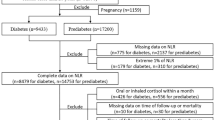Abstract
Objective
Atherosclerosis is considered a chronic inflammatory condition. The immune system is a key mediator in the initiation and progression of atherosclerosis. In a previous study, we found that the immune system was activated in diabetes and that total white blood cell (WBC) counts were elevated significantly in diabetic patients. To investigate whether WBC subtype counts in newly diagnosed diabetes are risk factors for future cardiovascular disease (CVD) events, we conducted a prospective population-based cohort study.
Methods
A total of 1498 newly diagnosed diabetic patients aged 40 to 70 years old were followed up for three years. Participants with previous CVD history and abnormal WBC counts were excluded. CVD events were recorded during follow-up.
Results
We found that the baseline lymphocyte counts were independently associated with cardiovascular events during follow-up, with the Exp (β) (95% CI) at 1.749 (1.084–2.821). Lymphocyte count ≥2.9 (109/L) was significantly associated with the development of CVD (HR, 2.29; 95% CI, 1.12–4.67). The corresponding incidence of CVD per 1000 person-year for the lymphocyte count ≤2.8 (109/L) and lymphocyte count ≥2.9 (109/L) groups were 11.26 and 26.38, respectively.
Conclusion
We concluded that even in a normal range, higher lymphocyte levels may result in a significantly higher CVD risk among diabetic patients. Lymphocyte count ≥2.9 (109/L) is an independent predictor of developing future CVD events.
Similar content being viewed by others
References
Alvarez CA, Lingvay I, Vuylsteke V, et al. Cardiovascular Risk in Diabetes Mellitus: Complication of the Disease or of Antihyperglycemic Medications. Clin Pharmacol Ther, 2015,98(2):145–161
Tousoulis D, Psarros C, Demosthenous M, et al. Innate and adaptive inflammation as a therapeutic target in vascular disease: the emerging role of statins. J Am Coll Cardiol, 2014,63(23):2491–2502
Fernandez-Real JM, Pickup JC. Innate immunity, insulin resistance and type 2 diabetes. Diabetologia, 2012, 55(2):273–278
Zhang H, Yang Z, Zhang W, et al. White blood cell subtypes and risk of type 2 diabetes. J Diabetes Complications, 2017,31(1):31–37
Ning G, Reaction Study G. Risk Evaluation of cAncers in Chinese diabeTic Individuals: a lONgitudinal (REACTION) study. J Diabetes, 2012,4(2):172–173
Bi Y, Lu J, Wang W, et al. Cohort profile: risk evaluation of cancers in Chinese diabetic individuals: a longitudinal (REACTION) study. J Diabetes, 2014,6(2):147–157
Camp RL, Dolled-Filhart M, Rimm DL. X-tile: a new bio-informatics tool for biomarker assessment and outcome-based cut-point optimization. Clin Cancer Res, 2004,10(21):7252–7259
Howard BV, Magee MF. Diabetes and cardiovascular disease. Current atherosclerosis reports, 2000,2(6):476–481
Legein B, Temmerman L, Biessen EA, et al. Inflammation and immune system interactions in atherosclerosis. Cell Mol Life Sci, 2013,70(20):3847–3869
Mendis SP N, B. Global Atlas on cardiovascular disease prevention and control. WHO, Geneva, 2011
American Diabetes A. 9. Cardiovascular Disease and Risk Management: Standards of Medical Care in Diabetes-2018. Diabetes care, 2018,41(Suppl 1):S86–S104
Brunetti ND. ‘Hot stuff’: inflammatory lymphocyte populations in acute coronary syndrome. Cell Mol Immunol, 2015,12(4):513–514
Hansson GK, Holm J, Jonasson L. Detection of activated T lymphocytes in the human atherosclerotic plaque. Am J Pathol, 1989,135(1):169–175
Song L, Leung C, Schindler C. Lymphocytes are important in early atherosclerosis. J Clin Invest, 2001,108(2):251–259
Author information
Authors and Affiliations
Corresponding authors
Ethics declarations
The authors have no conflict of interest.
Additional information
This work was supported by the National Key R&D Program of China (No. 2016YFC0901200 and No. 2016YFC0901203), Shanghai Pujiang Program (No. 2019PJD033), the Shanghai Science and Technology Commission (No. 15411953200, No. 10411956600 and No. 14ZR1427400), the National Clinical Research Center for Metabolic Diseases (No. 2013BAI09B13), the National Key New Drug Creation and Manufacturing Program of Ministry of Science and Technology (No. 2012ZX09303006-001).
Rights and permissions
About this article
Cite this article
Zhang, Hm., Li, Xy., Lin, N. et al. Lymphocytes ≥ 2.9 (109/L) in Newly Diagnosed Diabetes Are A Predictor of Future CVD Events. CURR MED SCI 42, 327–332 (2022). https://doi.org/10.1007/s11596-022-2541-4
Received:
Accepted:
Published:
Issue Date:
DOI: https://doi.org/10.1007/s11596-022-2541-4




